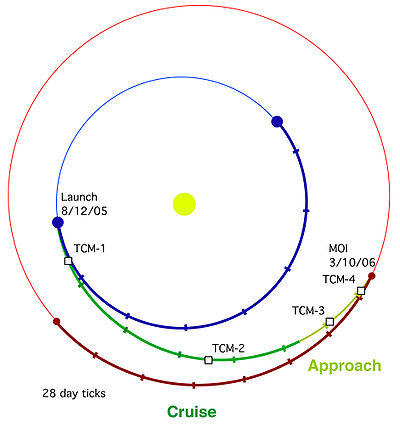In this part we explore the details of the navigational issues of getting the rover to Mars and why we talk of landing ellipses and not just an X-ed target on the map.
Anything landing on Mars needs a target. Our target is Gale
crater, 5.4°South by 137.8°East. Then we need to plan the flight path which
should demand as little fuel as possible to help reduce costs. Mars flights
usually proceed every 2.5 years when Mars and Earth are closest. But we don’t
just go in a straight line to get there. Why? Because it would be
gravitationally expensive (moving away from the sun, you have to use energy to
overcome its gravitational pull) and even if you go that way by the time you
reach the planet it would have already have moved out of the way along its
orbit. So we use a route called a Hohmann transfer orbit.
 |
| MRO following Hohmann orbit transfer (NASA) |
Essentially, this trajectory allows an object to be easily
moved from one orbit to another in the same plane.
On Mars approach the space craft has to approach the planet
in a particular direction or angle. If the angle is too shallow it would skip
across the Martian atmosphere and be lost to space. If too large there might
not be enough ‘atmosphere’ available to slow down the space craft adequately.
NASA has released a nice graphic showing how it’s all done.
Here it is below.
 |
| Needle and thread situation (NASA/JPL) |
Mission navigators are targeting an area above Mars’ area of
gravitational influence or ‘gravity well’ measuring 2.8km by 11.5km. The centre
of this box is where they wish to be aiming at directly. If they stay true to
this course Mars’ gravity will pull at the spacecraft towards the Martian
surface. To enable accurate targeting the mission planners have a series of
course correction manoeuvres that are done to compensate any deviation from the
pathway intended. Four such corrections have been done so far with a fifth
cancelled recently because they are spot on so far.
Since landers usually come at an angle during the EDL (Entry,
Descent and Landing) phase, the areas on the surface where we would likely
touchdown are spread out in to the form of an oval. Draw an ellipse around it and
you have your landing ellipse. The reason why we have an ellipse is because
various factors can cause the space craft to veer slightly out of its course as
it comes down like winds, momentum et cetera. The centre of the ellipse represents
the most likely place of touchdown and the edges the least likely. The glaring
difference between Curiosity’s landing ellipse and other ellipses is Curiosity’s
is very small. It measures only 6.4 by 19.3km compared to the rover Opportunity’s
87 by 11km. Curiosity’s smart landing systems really do pay off to achieve accuracy
in landing never before seen.
 |
| Curiosity's original 20 by 25km ellipse superimposed on the new 6.4 by 19.3km ellipse which brings the rover closer to its goal, mount Sharp yonder (NASA/JPL). |
So that’s why we have an oval and not just an ’X marks
the spot’.
No comments:
Post a Comment